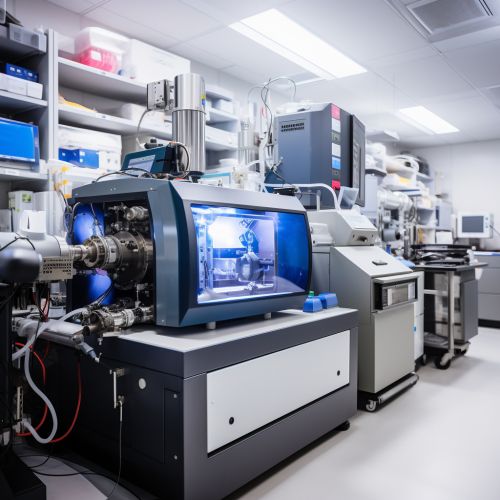Tandem Mass Spectrometry
Introduction
Tandem mass spectrometry (MS/MS) is a specialized form of mass spectrometry, where the basic principle is the creation, manipulation, and detection of ions. It is a powerful analytical tool used for qualitative and quantitative analysis of complex mixtures in various scientific fields such as biochemistry, pharmacology, and environmental science.


Principles of Operation
Tandem mass spectrometry involves multiple steps of mass spectrometry selection, with some form of fragmentation occurring in between the stages. The process typically involves ionizing a sample, separating the ions based on their mass-to-charge ratio (m/z), and then detecting the ions. The "tandem" in the name refers to the multiple stages of mass spectrometry involved.
Ionization
The first step in tandem mass spectrometry is ionization, where molecules from the sample are converted into gas-phase ions. This can be achieved through various methods such as electrospray ionization (ESI), matrix-assisted laser desorption/ionization (MALDI), or electron ionization (EI).
Mass Selection
After ionization, the ions are separated based on their mass-to-charge ratio (m/z) in the first mass analyzer. The ions with a specific m/z are selected and passed to the next stage. This process is also known as mass filtering.
Fragmentation
The selected ions are then fragmented, usually by collision with a gas in a process known as collision-induced dissociation (CID). The fragments produced are then analyzed in a second mass analyzer.
Detection
The fragmented ions are then detected, and a spectrum is produced. The spectrum represents the relative abundance of the different ions detected.
Applications
Tandem mass spectrometry has a wide range of applications in various scientific fields.
Biochemistry
In biochemistry, tandem mass spectrometry is used for protein identification and sequencing. It can also be used for the analysis of lipids, carbohydrates, and other biological molecules.
Pharmacology
In pharmacology, tandem mass spectrometry is used for drug discovery and development. It is also used for the detection and quantification of drugs in biological samples, which is crucial in therapeutic drug monitoring and toxicology.
Environmental Science
In environmental science, tandem mass spectrometry is used for the analysis of pollutants and other environmental contaminants. It can also be used for the analysis of trace elements in various samples.
Advantages and Limitations
Tandem mass spectrometry offers several advantages over other analytical techniques. It provides high sensitivity and specificity, making it ideal for the analysis of complex mixtures. It also allows for the identification and quantification of molecules in a sample, even in the presence of other similar molecules.
However, tandem mass spectrometry also has some limitations. The technique requires expensive and sophisticated equipment, and it requires skilled operators. Additionally, the interpretation of the results can be complex, especially for complex mixtures or large biomolecules.
